Shala K. Howell's Blog, page 5
August 20, 2021
Book Review: The Famoux by Kassandra Tate
NOTE: This post contains affiliate links to Bookshop.org, an online bookstore that provides financial support to local, independent bookstores. By the time I wrote this post, Bookshop.org had already raised $15.3m for local bookstores. If you use the links in this post to purchase a book or two on Bookshop.org, I’ll earn a commission on your book purchase, as will your preferred independent bookshop. You can also find these books in the new Caterpickles Bookstore. Regardless of whether you use my links or visit the Caterpickles Bookstore, I’m glad you spent part of your day reading Caterpickles. Learn more about Affiliate Links, the Caterpickles Bookstore, and why I decided to become a Bookshop.org Affiliate.
The Famoux by Kassandra Tate
Genre: Young Adult
Publisher: Wattpad Books
Year Published: 2021
Format: Paperback
Source: Purchase
My Rating: 


My Review:“Fame can be deadly. Out of the wreckage of environmental collapse, the country of Delicatum emerged. Its most popular celebrities are the Famoux, uniquely beautiful stars of a reality TV show called the Fishbowl. In a world still recovering from catastrophe, they provide a 24/7 distraction.Sixteen-year-old Emilee Laurence is obsessed with the Famoux–they provide a refuge from her troubled home life and the bullies at school. When she receives an unimaginable offer to become a member herself, she takes it. Leaving behind everything she’s ever known, Emilee enters a world of high glamour and even higher stakes.Because behind their perfect image lies an ugly truth–an anonymous stalker has been dictating the Famoux’s every move, and being popular really is a matter of life or death.”
From the book description on Bookshop.org



I did not expect to like this book, but The Fourteen-Year-Old strongly recommended it to me so I gave it a try. There were some rough patches early on involving some weird word choices. The storyline also reminded me a bit too much of the portion of The Hunger Games where the sacrifices are dressed up and introduced to the Districts.
I kept reading though, because I really wanted to know what my daughter liked so much about this book. Much to my surprise, I became pretty wrapped up in the events and started caring a lot about some of the characters, and now I’m cranky book two isn’t already out.
What about you?What have you been reading lately?
Related Links:
Book Reviews: Dance of Thieves and The 7 1/2 Deaths of Evelyn Hardcastle (Caterpickles)
August 13, 2021
Book Review: Timmy Failure: Mistakes Were Made by Stephen Pastis
NOTE: This post contains affiliate links to Bookshop.org, an online bookstore that provides financial support to local, independent bookstores. By the time I wrote this post, Bookshop.org had already raised $15.3m for local bookstores. If you use the links in this post to purchase a book or two on Bookshop.org, I’ll earn a commission on your book purchase, as will your preferred independent bookshop. You can also find these books in the new Caterpickles Bookstore. Regardless of whether you use my links or visit the Caterpickles Bookstore, I’m glad you spent part of your day reading Caterpickles. Learn more about Affiliate Links, the Caterpickles Bookstore, and why I decided to become a Bookshop.org Affiliate.
Timmy Failure: Mistakes Were Made by Stephen Pastis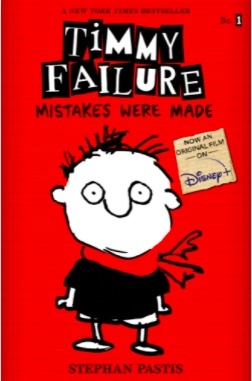
Genre: Middle Grade
Publisher: Candlewick Press
Year Published: 2015
Format: Hardback
Source: Purchase
My Rating: 


My Review:“Take Timmy Failure–the clueless, comically self-confident CEO of the best detective agency in town, perhaps even the nation. Add his impressively lazy business partner, a very large polar bear named Total, and what you have is Total Failure, Inc. From the offbeat creator of Pearls Before Swine comes an endearingly bumbling hero in a hilarious caper accompanied by a whodunit twist. With perfectly paced visual humor, Stephan Pastis gets readers snorting with laughter, then slyly carries the joke a beat further–or sweetens it with an unexpected poignant moment–making this a comics-inspired story that truly stands apart from the pack.”
From the book description on Bookshop.org



Like the Diary of a Wimpy Kid series by Jeff Kinney and the Captain Underpants series from Dav Pilkey, this book makes effective use of frequent, humorous illustrations to create an accessible reading experience that bridges the gap between picture books and chapter books for readers still building their confidence.
And while there are times when the only option is to roll your eyes, there are also genuinely funny moments. As well as some surprisingly poignant ones, such as when Timmy matter of factly explains that it’s important for his detective agency to succeed so that he can help his financially strapped mom pay the bills.
This excerpt from the Timmy Failure website does a much better job of conveying the experience of reading these books than I can do with words alone.
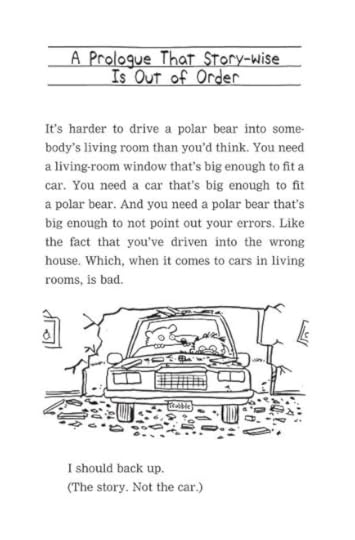 Excerpt from
Timmy Failure: Mistakes Were Made
, via the Timmy Failure website. Although I’ve only reproduced the prologue here, the full excerpt includes Chapters 1-4 as well. It’s really quite a generous sample, and should be more than enough to decide whether you (or your reader) will enjoy the book.
Excerpt from
Timmy Failure: Mistakes Were Made
, via the Timmy Failure website. Although I’ve only reproduced the prologue here, the full excerpt includes Chapters 1-4 as well. It’s really quite a generous sample, and should be more than enough to decide whether you (or your reader) will enjoy the book. So why only three teacups?
There are many things to love about this book, but the way Timmy treats his friends is not one of them. He’s frequently cruel in speaking to and about them. So if your child does dive into these books, it may be worth reading at least one along with them, so that you can have a conversation about more effective and kinder ways of dealing with their sometimes annoying but otherwise likable friends.
What about you?What have you been reading lately?
Related Links:
What’s the Eight-Year-Old Reading this Week (Caterpickles)
August 8, 2021
Some personal news…
As you know, I’ve been volunteering at a local middle school library for a few years now. Recently, I was offered the chance to serve as a long-term substitute library assistant for the month of August in that very same library. Naturally, I said yes.
Which is why for the next month or so, this blog is likely to be mostly about books.
The kids come back on Wednesday. As my daughter would say, I have two feelings about this. On the one hand, I am so very excited to be back in this space that I love and cannot wait to start matching readers with their new favorite books again.
On the other hand, it seems pretty clear that kids do in fact catch and spread COVID. So there’s that. Guess I’m about to find out just how well masks + vaccines for folks 12 and up work in a school setting.
Fingers crossed that with appropriate precautions (vaccines, masks, hand washing, no face touching, and no licking of surfaces as my teacher buddies would say) it really is ok to resume enjoyable life again.
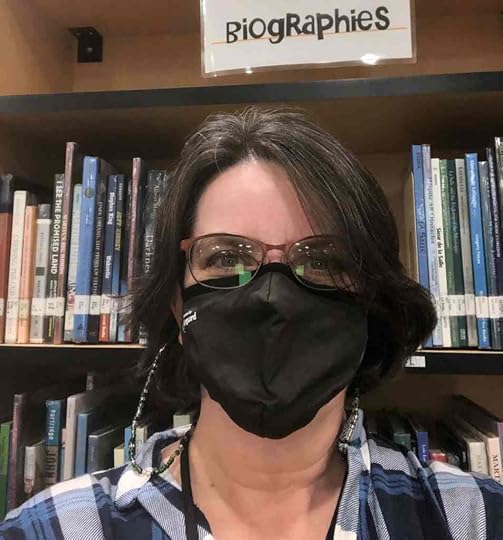 Me, in a quiet moment, before the hordes of eager readers arrive later this week. (Photo: Also me.)
Me, in a quiet moment, before the hordes of eager readers arrive later this week. (Photo: Also me.)
July 9, 2021
Where does the phrase “raining cats and dogs” come from anyway?: Part 2
NOTE: The link to Robert Hendrickson’s Facts on File reference text is an affiliate links to Bookshop.org, an online bookstore that provides financial support to local independent bookstores. By the time I wrote this post, Bookshop.org had already raised more than $14m for local bookstores. If you use the link in this post to purchase a book or two on Bookshop.org, I’ll earn a commission on your book purchase, as will your preferred independent bookshop. You can also find Hendrickson’s book in the Caterpickles Bookstore. Regardless of whether you use my links or visit the Caterpickles Bookstore, I’m glad you spent part of your day reading Caterpickles. Learn more about Affiliate Links, the Caterpickles Bookstore, and why I decided to become a Bookshop.org Affiliate.
If you’re just joining us, we are hip-deep into a two-week investigation into the origin of the phrase “raining cats and dogs.” In last week’s post, we discussed the possibility that it might have come either from lax sanitation practices in Elizabethan England (Theory #1) or the “it shall raine dogs and polecats” line in Richard Brome’s 1652 play, “The City Witt” (Theory #2).
Those theories, while fun to explore, were only 2 of 7(!) possibilities I uncovered in the course of my investigation. Today, I’ll examine the remaining 5 and pick my favorite.
Theory #3: The phrase “raining cats and dogs” was popularized by Jonathan Swift in the 1700s I promised we’d get back to you this week, Mr. Swift, and look, here we are. (Charles Jervas portrait of Jonathan Swift, 1718, Public Domain via Wikimedia Commons)
I promised we’d get back to you this week, Mr. Swift, and look, here we are. (Charles Jervas portrait of Jonathan Swift, 1718, Public Domain via Wikimedia Commons) During my investigation, I learned that the Library of Congress devotes a portion of its website to resolving these sorts of questions, which it dubs Everyday Mysteries. Their page on “raining cats and dogs” mentions Brome’s play, but only as a starting point for discussion. They are far more interested in the role Jonathan Swift may have played.
Some 58 years after Brome’s “dogs and polecats” Swift described these intense floods in his as being intense enough to sweep “drowned puppies” and “dead cats” through the streets. You can read the entire poem on the Poetry Foundation’s website here. The key phrases appear in the final stanza.
Now from all parts the swelling kennels flow,
And bear their trophies with them as they go:
Filth of all hues and odors seem to tell
What street they sailed from, by their sight and smell.
They, as each torrent drives with rapid force,
From Smithfield or St. Pulchre’s shape their course,
And in huge confluence joined at Snow Hill ridge,
Fall from the conduit prone to Holborn Bridge.
Sweepings from butchers’ stalls, dung, guts, and blood,
Drowned puppies, stinking sprats, all drenched in mud,
Dead cats, and turnip tops, come tumbling down the flood.
Final stanza of Jonathan Swift’s 1710 poem “A Description of a City Shower” via Poetry Foundation
You may have noticed that Swift never expressly uses the phrase “raining cats and dogs” in his poem. It wasn’t until his 1738 satire, “Complete Collection of Genteel and Ingenious Conversation,” that Swift explicitly used the phrase “raining cats and dogs” to describe the weather. The Library of Congress speculates that by 1738, Swift would have been sufficiently popular to have prompted the general public to begin using the idiom in regular conversation.
Did he really though? Or did he just use a phrase that was already widely used in conversation by society at large?
In Episode 45 of their fascinating podcast, Word Matters, the linguists at Merriam Webster point out that it can be really hard to tell when the first literary mention of a word or phrase is in fact the first time that word or phrase has ever been used. Maybe the author really did come up with something completely original. But maybe they were just the first to write down an already commonly known word or phrase. Whatever the case was here, it seems fairly clear that Swift was popular enough to introduce the phrase “raining cats and dogs” to a much wider audience.
Theory #4: The phrase “raining cats and dogs” comes from a Greek phrase meaning “an unlikely occurrence“Having thoroughly explored the possible literary origins of the phrase, I returned to Hendrickson’s original entry to see what else he had to offer me. After dispensing with the flash flood and Brome theories, Hendrickson launched into three merry speculations that were all essentially variations on the theme of English speaker hears phrase in another language and misunderstands it, and so an idiom is born. The first of these apparently derives from a Greek saying which Hendrickson claims sounds to the English ear like raining cats and dogs but actually means an unlikely occurrence.
One of the nice features of Google Translate is that you can use it to hear what various phrases would sound like in other languages. Since I had it up on my computer already (you’ll recall I used it in last week’s post), I simply asked it to translate an unlikely occurrence from English to Greek. I then played the resulting translation ένα απίθανο συμβάν [éna apíthano symván] on my computer speakers so I could decide for myself whether this seemed plausible.
Short answer: No. Perhaps this was not the phrase Hendrickson was thinking of.
Curious, I tried Dogmata Polla Sophon [Δόγματα Πολλά Σοφών] next. After all, Hendrickson did directly reference the lines in Brome’s play in which it appeared. That was closer, although having grown up Catholic in Texas, I heard the first two words in this phrase as dogma and the Spanish pollo [chicken].
If this is the proper origin story, then we should all take a moment to be grateful that I wasn’t in charge of developing this particular idiom, because if I had, we’d all be wandering around exclaiming about how it was raining theology and chickens.
Clearly I’m missing something here. Which honestly isn’t all that surprising. Greek is a fairly robust language, and not being or having easy access to a native Greek speaker, identifying the precise phrase that Hendrickson thinks sounded enough like “raining cats and dogs” to have spawned the idiom seemed like a bit of a long shot.
Naturally, the Library of Congress has something to say about this as well. They identify the Greek phrase in question as being cata doxa, which they translate as “contrary to experience or belief.” Which I suppose implies that English speakers might have started using a mispronounced version of this Greek phrase to express disbelief at how unusually hard it’s raining out there.
For the record, Google Translate claims cata doxa means “by glory.” I didn’t know what to do with that, but I had two more conjectures from Hendrickson to explore and there was also the question of where my brother had gotten his theory about thatched roofs from, so I decided to stop here and move on to my next option.
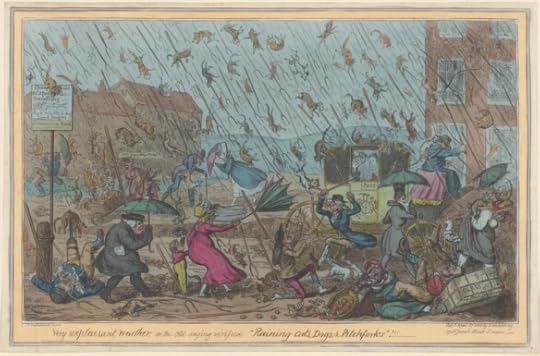 “Very unpleasant weather”, an etching by George Cruikshank, 1820. (Public domain, via the National Gallery of Art. Full Disclosure: I learned this image existed through the Library of Congress Everyday Matters website.)Theory #5: The phrase was coined by an English speaker who misheard an obscure French word for waterfall, catadoupe
“Very unpleasant weather”, an etching by George Cruikshank, 1820. (Public domain, via the National Gallery of Art. Full Disclosure: I learned this image existed through the Library of Congress Everyday Matters website.)Theory #5: The phrase was coined by an English speaker who misheard an obscure French word for waterfall, catadoupeNext up in Hendrickson’s entry was the conjecture that the phrase “raining cats and dogs” was coined by an English speaker who heard an obscure French word for waterfall, catadoupe, misunderstood the context for it, and decided that the person speaking to him was saying something about how it was raining cats and dogs outside. Since Google Translate was open anyway, I asked it to pronounce catadoupe for me.
Google Translate actually identified it as Portuguese, which made me chuckle. (In Hendrickson’s defense, however, it wasn’t hard to find another online foreign language dictionary that identified catadupe as an alternative French word for waterfall.)
Regardless, whether you ask Google Translate to pronounce catadoupe with a French or Portuguese accent, it’s clearly similar to cat et dupe, I mean, dog. I can see why someone might posit this as the origin story.
Our friend the Library of Congress has a slightly different take on this theory. They identify it as an Old English word catadupe, which may have been based on the Latin catadupa, which was borrowed from the classical Greek κατάδουποι (katádoupoi), which, our trusted friend the Library of Congress assures me, referred to the cataracts of the Nile River.
So maybe “raining cats and dogs” is based on the Greek after all.
Still, when all is said and done, we’re talking about a phrase based on someone trying to say “it’s raining waterfalls” but committing a malapropism instead.
Theory #6: The phrase raining cats and dogs is based on Norse mythologyThe final origin story is just a throwaway line by Hendrickson, but I decided it was worth a look nonetheless. Apparently in Norse mythology, Odin the storm god regularly appears in images as being attended by dogs. Despite this association, the Norse typically blamed cats for storms. A comprehensively minded English speaker might well have concluded from this that to be safe, she’d better include both species in her storm description. Hence the origin of the phrase “raining cats and dogs.”
When I consulted the Library of Congress for their opinion on this theory, they agreed with the bit about Odin and the dogs being associated with the wind, but asserted that witches, and their feline familiars, were the ones associated with heavy rain. Apparently sailors used to think that witches liked nothing better than to saddle up their brooms and take their cats for a flight during intense rainstorms.
 “You’re not going to make me do that, are you?” (Photo: Shala Howell)
“You’re not going to make me do that, are you?” (Photo: Shala Howell)Anyway, according to this theory, Northern sailors might well have used the phrase “raining cats and dogs” to describe a storm with high winds and heavy rain.
That left one last speculation: my brother’s tale about the thatched roofs.
Theory #7: The phrase “raining cats and dogs” refers to the unfortunate tendency of cats and dogs to fall through thatch roofs during heavy rain stormsSorry, Paul. The Library of Congress says this last one’s just not true.
So what do I think (for now at least)?I love a good literary reference. I am also quite attached to the idea that writers can become popular enough to literally change the way people think and talk about the world around them. I choose to believe that Jonathan Swift was instrumental in giving us this particular idiom.
Ironically, that means I didn’t pick any of the theories in Hendrickson’s entry on the subject, even though I had tried to save time by turning to him first. Some shortcut that turned out to be.
Interestingly, Hendrickson closes his entry with a reference to his book’s entry on Fishfall, which is just a deeply satisfying circular conclusion to this entire enterprise (which you’ll recall, began with me taking a second look at what people think causes the annual fish rain in Honduras), even if his entry on fishfall doesn’t mention Yoro, Honduras and its annual rain of fish at all. Hendrickson sticks strictly to fish- and frog falls that can be explained by waterspouts.
Related links:
Update to a Past Caterpickles: “Why does it rain fish in Honduras?” (Caterpickles)Where does the phrase “raining cats and dogs” come from? (Caterpickles)“What is the origin of the phrase raining cats and dogs?” (Library of Congress, Everyday Mysteries)“What Happened to Google’s Effort to Scan Millions of University Library Books?” (EdSurge)The Dramatic Works of Richard Brome (Google Books)“A Description of a City Shower” by Jonathan Swift (Poetry Foundation)Other resources used in researching this post:
Google TranslateGoogle BooksRobert Hendrickson’s Facts on File Encyclopedia of Word and Phrase Origins. His entry on “raining cats and dogs” appears on page 696. The Word Matters Podcast from Merriam Webster, available online here or from your favorite podcast app. The episode I referred to in this post is Episode 45 from June 15, 2021.July 4, 2021
Happy Fourth of July!
To my U.S. readers — I hope this Fourth of July holiday is filled with food, fun, and time with loved ones.
To my international readers, I hope you have an unusually pleasant Sunday. 
 Throwback Holiday: My daughter’s first bicycle, all dressed up and ready for Norwood MA’s 2012 Fourth of July Children’s Parade. (Photo: Shala Howell)
Throwback Holiday: My daughter’s first bicycle, all dressed up and ready for Norwood MA’s 2012 Fourth of July Children’s Parade. (Photo: Shala Howell)Thanks for stopping by Caterpickles. Stay safe out there.
July 2, 2021
Where does the phrase “raining cats and dogs” come from anyway?
NOTE: The links to Robert Hendrickson’s Facts on File reference text and Steven Johnson’s The Ghost Map are affiliate links to Bookshop.org, an online bookstore that provides financial support to local independent bookstores. By the time I wrote this post, Bookshop.org had already raised more than $14m for local bookstores. If you use the link in this post to purchase a book or two on Bookshop.org, I’ll earn a commission on your book purchase, as will your preferred independent bookshop. You can also find these books in the Caterpickles Bookstore. Regardless of whether you use my links or visit the Caterpickles Bookstore, I’m glad you spent part of your day reading Caterpickles. Learn more about Affiliate Links, the Caterpickles Bookstore, and why I decided to become a Bookshop.org Affiliate.
You may recall from last week’s post that while I was researching the fish rains in Honduras, The Fourteen-Year-Old wandered in. After skimming the National Geographic article on “Strange Rains,” she was struck by their need to point out that while small animals like fish, polliwogs, and frogs are often scooped up by waterspouts and dumped with the rain, cats and dogs never are.
“If it never actually rains cats and dogs, Mommyo, where does the phrase ‘it’s raining cats and dogs’ come from?”
That, I told her, would have to wait for some other time when I wasn’t knee deep in fish rain facts. We made a Caterpickles agreement that I would answer the question this week.
What did we know?When I mentioned to my brother that I had spent a good chunk of the previous week researching animal rains and was going to spend the next week tracing down the origin of the phrase, “it’s raining cats and dogs,” he promptly volunteered a theory of his own. “It has to do with thatched roofs, Shala.”
Apparently, in the before times, when thatched roofs were common, cats and dogs would perch on top of them. The problem with thatch roofs, though, is that they don’t stand up to a hard driving rain that well. When a storm came and weakened the thatch, whatever cats and dogs were perched on it at the time would fall through it and into people’s houses.
Hence the phrase, “it’s raining cats and dogs.”
 “That’s a terrible story. I hate it.” (Photo by Burak Kebapci on Pexels.com)
“That’s a terrible story. I hate it.” (Photo by Burak Kebapci on Pexels.com)My brother knows a lot of things, but he’s also very good at tricking me with tales that are just plausible enough. As a result, I absolutely one hundred percent want to believe him, and yet…
Could that possibly be true? Or is it just an old(er) brother’s tale?
Where could we look for more information?Relatively early in my maternal career, it became clear that I was facing years of answering “Why is it called that?” questions about the origins of various words, phrases, and idioms, such as , Fifth disease, or flea markets. After fielding the first barrage, I invested in a copy of Robert Hendrickson’s Facts on File Encyclopedia of Word and Phrase Origins for our home library. Hendrickson has been writing about various words, phrases, and idioms and why we use them for decades, and has saved me countless hours in the process.
Sure enough, Hendrickson had an entry for the phrase “raining cats and dogs.” It’s only about 180 words long, but that was long enough for Hendrickson to pack in at least four conjectures on the origin of the term. (Oddly, he didn’t include my brother’s thatch roof theory.)
The theories Hendrickson did provide gave me plenty to work with. Trying to figure out which one was most likely to be correct sent me on a fascinating linguistic goose chase.
By the time I was done researching everything, I had 7(!) different origin stories to choose from. Seven is far too many to talk about in one post, so I’m going to tell you about two of them today, and save the remaining five (which are much shorter) for next week.
Let’s get started.
Theory #1: The phrase ‘raining cats and dogs’ refers to literal bodies of dead cats and dogs carried through the flooded streets of 17th Century England after an especially hard rain.In his entry, Hendrickson speculates that the phrase “raining cats and dogs” was first coined in response to the distressing tendency of 17th century English city streets to become raging rivers during heavy downpours. Hendrickson theorized that the bodies of dead dogs and cats would inevitably have been among the various types of street filth flushed out during these storms. Hence the phrase, “raining cats and dogs.”
Can that possibly be true? Well, maybe.
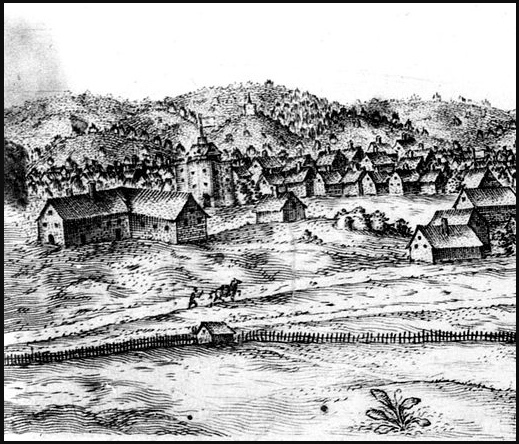 London in the 16th century: Just how filthy was it? (Detail from “The View of the Cittye of London from the North towards the South“, an engraving by Abram Booth, c. 1599, Public Domain via Wikimedia Commons)
London in the 16th century: Just how filthy was it? (Detail from “The View of the Cittye of London from the North towards the South“, an engraving by Abram Booth, c. 1599, Public Domain via Wikimedia Commons)I’ve gathered from other reading on life in the (slightly earlier) Elizabethan era that in the days before the routine street sanitation, these sorts of flash floods were just about the only systematic way the streets were cleaned.
In a March 2016 article for the British Library, Liza Picard points out that with only an informal collection of street pickers to clean them, Elizabethan streets quickly became clogged with muck from the teeming mass of horses, pigs, cattle, sheep, and humans who used them daily. It’s not hard to imagine that the occasional cat, rat, dog, or other animal carcass among all that muck, especially in a relatively crowded place like London.
A nice hard rain that swept at least some of this mess into the Thames might have improved London’s streets considerably, even if it did throw London’s primary source of drinking water into peril.
And in fact, London’s famed sewer system wasn’t constructed until the Victorian era, after a particularly intense outbreak of cholera in 1853.
So the theory seems plausible. Maybe even possible. But likely? Hard to say. It depends on how unsanitary the streets of England really were during the reign of the Tudors. This 1934 article from the American Journal of Public Health certainly makes a passionate argument that we have greatly overestimated the muck of the 16th century.
“In studying the development of public health activities in 16th century England, we find that it runs parallel with and, in fact, is contingent upon the growth of a strong, centralized government under the Tudors. The attitude of the State, especially in the reign of that amazing ruler, Elizabeth, was an enlightened one, seeking to guard and foster the welfare of all of the people. We are apt to forget today that in Elizabeth’s time government regulation of industry and of many phases of the life of the people was the accepted order. It is significant that from such a philosophy of government sprang many of our basic public health procedures.
– Sanford V. Larkey, M.D. “Public Health in Tudor England.” American Journal of Public Health
“Manifestations of this ideal are seen in the various efforts to better the sanitary and health conditions of the people, not only in attempting to control epidemics, but in aiming also to eradicate some of the fundamental factors in the cause and spread of disease.
“Housing plans were proposed to relieve the overcrowding of cities, pure food laws were passed, rules made to keep the streets clean, and a commission appointed to regulate the disposal of sewage. All of these projects had the definite purpose of protecting and improving the health of the populace….
“In almost every respect the towns were cleaner and more healthy in the 16th century than they were in the 19th Century.”
and the Nation’s Health, November 1934, pp. 1099-1102.
Clearly, if you really wanted to see streets that were a menace to public health, you would do better to time travel to 19th century London, the period Johnson describes in The Ghost Map: The Story of London’s Most Terrifying Epidemic and How It Changed Science, Cities, and the Modern World.
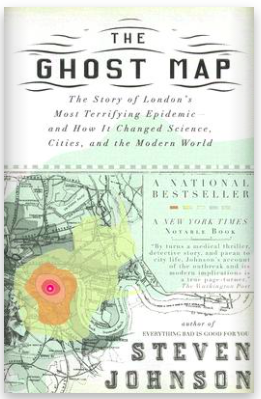 If you’re interested in these sorts of things, Steven Johnson’s wonderful book
The Ghost Map
chronicles both the 1853 cholera epidemic and how a physician and a local curate’s desperate attempts to contain it forever changed our understanding of disease and sparked the development of the famed London sewer system.Theory #2: The phrase “raining cats and dogs” comes from a 1652 British play written by Richard Brome
If you’re interested in these sorts of things, Steven Johnson’s wonderful book
The Ghost Map
chronicles both the 1853 cholera epidemic and how a physician and a local curate’s desperate attempts to contain it forever changed our understanding of disease and sparked the development of the famed London sewer system.Theory #2: The phrase “raining cats and dogs” comes from a 1652 British play written by Richard BromeAfter making his case for why “raining cats and dogs” might have referred to the sort of intense rain capable of cleaning filthy Elizabethan streets, Hendrickson decided to test his hypothesis by checking the first use of the idiom in the written record. In this case, the first usage of the phrase Hendrickson could find was in Richard Brome’s 1652 play, The City Witt, which includes the line “it shall rain dogs and polecats.”
Unfortunately for this origin story, polecats are more like weasels than cats. Hendrickson contented himself with noting that this probably means the idiom didn’t originate with Brome’s play. He showed no interest in exploring the matter further.
Hendrickson may have been done, but I wasn’t.I decided to track down the Richard Brome play from Hendrickson’s entry and review the evidence for myself.
I don’t know how familiar you are with the Google Books project. I learned Google Books existed because my husband, who works at Google, told me about it. Basically, Google has committed to working with various university libraries to create a publicly accessible digital archive of their collections. There are copyright issues with works printed in the last 100 years, so only snippets are available of most of them, but the archive is a great resource for tracking down out of print works in the public domain.
This situation, in which I want to quickly check a quote in a play by a 17th century writer I’d never heard of, is tailor-made for a Google Books hunt.
 Portrait of Richard Brome, from the 1653 edition of Five New Plays by Richard Brome. I am so curious about the meaning of that laurel wreath. Do you know why it’s there? If so, let me know in the comments. Inquiring minds want to know. (Via Wikimedia Commons, Public Domain.)
Portrait of Richard Brome, from the 1653 edition of Five New Plays by Richard Brome. I am so curious about the meaning of that laurel wreath. Do you know why it’s there? If so, let me know in the comments. Inquiring minds want to know. (Via Wikimedia Commons, Public Domain.)Thanks to the good folks at Google Books, I found an 1873 collection of 15 comedies by Richard Brome. One of them, thankfully, was The City Witt. On opening it, I learned that the full title of the play is a glorious reflection of the world in Brome’s time: The City Witt (Or, The Woman Who Wears Breeches, A Comedy).
Searching the play for the word “polecat” quickly brought me to page 334, where I learned that the character who spoke the line is named Sarbego. In contrast to other characters in the play who are identified by their occupations or relationships (apprentice, father, maid, wife, and so on.), Sarbego is identified simply as “A Pedant.”
A mere 26 words from the play provides the context for both the phrase “dogs and polecats” and Sarbego’s character description:
“[Sarbego] From henceforth Erit Fluvius Deucalionis,
The world shall flow with dunces; Regnabitque,
and it shall Raine
Dogmata Polla Sophon, Dogs and Polecats and so forth.”
Brome, Richard. The Dramatic Works of Richard Brome: Containing Fifteen Comedies Now First Collected in Three Volumes …. United Kingdom, J. Pearson, 1873. P. 334
It took me an embarrassingly long time to realize that those italicized phrases were most likely words pulled from another language, and not the names of characters interrupting each other to deliver the lines in some sort of cobbled together chorus line. What can I say? It has been hard enough for me to read books lately, much less Elizabethan-era plays.
However, I did finally get there. The fact that the cast notes identified Sarbego as a pedant clued me in to what was likely going on here. Given the Elizabethan playwright’s tendency to poke fun at stuffy academic types in their comedies — see Polonius in Hamlet for another example — odds were good that at least some of these fancy foreign phrases would be partially or completely made up.
Not being a world class genius versed in the classics like Sarbego, I didn’t recognize any of the terms myself.Fortunately, Google has yet another tool for that. Google Translate is a free service that lets you drop in phrases from other languages and have them translated for you. You can tell Google which languages to use, or you can simply dump in a phrase and ask Google to identify the language for you.
In this case, I thought the phrases might be Latin, but I wasn’t sure, so I asked Google to detect the languages, with mixed results.
Google Translate identified Erit Fluvius as a Latin phrase meaning “a stream will,” but it didn’t recognize either Deucalionis or Regnabitque. Those could easily have been the made-up words. To my inner ear Deucalionis suggested the ideas of dunces, and Regnabitque seemed like a collection of Latin-esque syllables that someone who learned just enough Latin to be dangerous might want to pass off as the Latin word for rain.
So I moved on to Dogmata Polla Sophon. Much to my surprise, Google Translate identified this as a Greek phrase meaning “doctrines of many wise men.”
Further evidence for my “pedant spouts nonsense for comedic effect” theory, but not necessarily helpful when it comes to the question of the origin of the phrase “raining cats and dogs.”
But wait, there’s more….Brome’s play was the only literary source Hendrickson documented. But in the course of my investigation, I came across a Library of Congress blog post that had some interesting thoughts on the role of Jonathan Swift, as well as a couple of other possibilities Hendrickson hadn’t even mentioned, including my brother’s tale of cats on a weak thatched roof.
But frankly, this feels like enough for one day, so let’s stop here and save the Jonathan Swift speculation and the remaining theories for next week.
 Just you wait, Jonathan. We’ll deal with you next week. (Charles Jervas portrait of Jonathan Swift, 1718, Public Domain via Wikimedia Commons)
Just you wait, Jonathan. We’ll deal with you next week. (Charles Jervas portrait of Jonathan Swift, 1718, Public Domain via Wikimedia Commons)Related links:
Update to a Past Caterpickles: “Why does it rain fish in Honduras?” (Caterpickles) (Caterpickles)“Why is it called that?”: The Flea Market Edition (Caterpickles)“Why is it called Fifth Disease?” (Caterpickles)“Seven Man Made Wonders: London Sewers” (BBC Home) “Cities in Elizabethan England” (British Library)“What Happened to Google’s Effort to Scan Millions of University Library Books?” (EdSurge)The Dramatic Works of Richard Brome (Google Books)“Public Health in Tudor England” (Archive of American Journal of Public Health)Other resources used in researching this post:
Google TranslateGoogle BooksRobert Hendrickson’s Facts on File Encyclopedia of Word and Phrase Origins. His entry on “raining cats and dogs” appears on page 696. Wikimedia CommonsJune 25, 2021
Update to a Past Caterpickles: “Why does it rain fish in Honduras?”
While I was busy not blogging this summer, it came to my attention that my daughter is 14. Which, by extension, means that this blog, which I started as a coping mechanism to deal with my then four-year-old daughter’s relentless curiosity, is 10 years old.
Goodness.
Thank you for reading Caterpickles all these years and keeping me motivated about writing in the process. You have no idea how many times over the years that this blog was the only thing I was able to write. Your presence here is truly a gift.
Anyway, I thought it would be fun to revisit a question post from the early days of the blog to see how well my answer has held up over time. After all, new information has a pesky habit of popping up and demanding that you take it into account.
It’s June, so my May 2015 post on the fish rains of Honduras is enjoying its annual resurgence in popularity. I decided to see how well it’s held up.
And that, Dear Reader, is how I learned that I’ve been woefully misled all these years about the entire thing.
But before I tell you where I went wrong, it’s seems only fair to remind you of what I’m talking about.
“Why does it rain fish in Honduras?”Every year in May or June, a massive thunderstorm forms in Yoro, Honduras, pelting the region with heavy rain for hours. After the storm passes, locals emerge to find the ground covered in small, blind, silver fish.
According to Atlas Obscura, the rain of fishes in Yoro, Honduras happens at least once a year, and has been going on since the 1800s. Locals call it the Lluvia de Peces (rain of fish). For most of them, it’s simply a miracle. A miracle that happens annually. Given that utter predictability, we couldn’t help but wonder if there was a more secular explanation.
Where could we look for more information?A trip to Honduras to witness the phenomenon for ourselves was out of the question. My daughter wasn’t willing to get several extra vaccinations, endure a long plane flight, and wait out a scary storm in Honduras just to get this answer. I wasn’t too thrilled about the potential expense. Especially since I was reasonably confident that we could find what we needed online.
The Atlas Obscura article mentioned that a team from the National Geographic had witnessed the phenomenon for themselves in the 1970s, so we decided to stop by the National Geographic website to see what, if anything, they had to say about it.
On the Education section of the site, we found a Resource Library article titled “Strange Rains”, which catalogued the various types of so-called animal rains that fall in various parts of the world. Bats, polliwogs, fish, snakes, and jelly fish all have an unfortunate tendency to get caught up in waterspouts and updrafts only to fall back to Earth with the rain. Although animal rains have been occurring off and on for centuries, National Geographic was careful to point out that they typically only involve relatively small animals, and not actual cats and dogs.
(My daughter popped in while I rereading the National Geographic article. She was struck by their comment on cats and dogs. “So why do we say it’s raining cats and dogs then?” That, I told her, would have to wait for some other time when I wasn’t knee deep in fish rain facts. We’ve penciled it in the Caterpickles Wonder Book for next week.)
Interestingly, there was no mention in that article of either the annual Lluvia de Peces downpour or the fabled 1970s National Geographic excursion that apparently witnessed it. Clearly, we would have to look elsewhere if we wanted to learn more about that.
Our search led to a July 2013 Live Science article, “Lluvia de Peces: When Fish Rain From the Sky,” written by Elizabeth Palermo. You may recall it as the primary source for that original Caterpickles post.
In it, Palermo presents three main explanations for the annual fish rain.
Theory #1: It’s God, providing food for the poor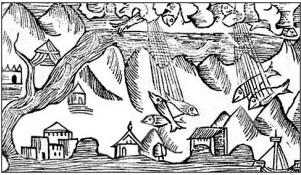 Rain of Fish by Olaus Magnus (Via Historical Mysteries)
Rain of Fish by Olaus Magnus (Via Historical Mysteries)Local legend has it that the fish are a blessing from Spanish missionary Father Jose Manuel Subirana, who was so heartbroken by the poverty and hunger he witnessed in Yoro in the 1860s that he asked God to provide them with a regular source of food.
Proponents of this theory point to the fact that the fish aren’t native to the region’s rivers and streams. Clearly, they must have come from somewhere else, like the Atlantic Ocean.
Theory #2: It’s waterspouts, scooping up fish from the Atlantic and carrying them 125 miles to YoroWhen tornadoes and other powerful storms move over water they can form waterspouts or powerful updrafts that suck up small fish and other aquatic life and dump them elsewhere.
The problem is that once those waterspouts encounter land, they lose power very quickly. It doesn’t seem all that likely that a waterspout could carry fish 125 miles over land from the Atlantic Ocean to Yoro. If waterspouts were the explanation, it seems much more likely that the fish would be dropped somewhere much closer to their home, like anywher in the Honduran province of Atlantida, which lies between Yoro and the Atlantic Ocean.
Also, what are the odds that a waterspout would form directly over a giant school of fish every spring for more than 100 years? If that were true, it would be a miracle.
Theory #3: The fish live underground and are forced up by the rainBoth the Atlas Obscura and the LiveScience articles mentioned a team of scientists from the National Geographic traveling to Honduras in the 1970s to investigate the fish rain for themselves.
According to these sources, the National Geographic team noticed that the washed-up fish were completely blind, and appeared to be freshwater, not salt water fish. That led them to conclude that the fish lived in an underground river. Based on that, they decided that the most likely explanation for the annual fish-basting of Yoro was that the heavy rains forced the subterranean fish above ground.
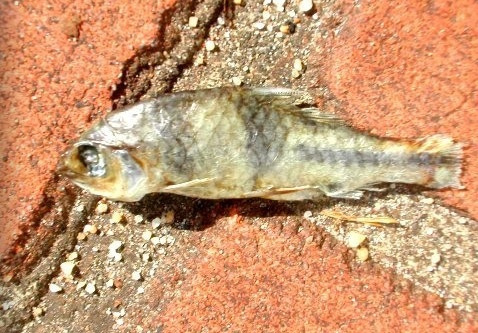 (Photo via Atlas Obscura)
(Photo via Atlas Obscura)This sounds plausible, but it has its own issues.
Let’s face it: Fish flushed out of their homes like earthworms after a heavy rain just aren’t as interesting as fish raining down from the sky. Also, apparently no one has found an egress point for this proposed underground river teeming with fish.
These are pesky issues, but in my original post, my daughter and I decided they weren’t pesky enough to throw the entire theory into question. Why would a National Geographic team lie about what they had found?
We decided that Theory #3 was the most likely explanation, and there the matter rested for six long years.
Wow, were we ever wrong about thatWhile checking the original sources for this post, I inevitably ran across several much more recent articles, including this one by Jack Palfrey for World Travel Guide: “Lluvia de Peces: Visiting the town that rains fish.”
Turns out, that fabled National Geographic team may have been just that — a fable.
Unlike the other writers on this topic, myself included, who just accepted the existence of that National Geographic team based on frequent mentions of it in various articles over the years, Palfrey set out to interview them or at least review the documentary evidence they brought back for himself.
Palfrey asked National Geographic to connect him with at least one member of that original expedition team. In response, a National Geographic staffer informed Palfrey that there was no record in either the virtual archive of past issues or in the database of past grants of an expedition to Honduras to document the annual rain of fishes. Thinking perhaps that the name of the geographic society had been blurred over time, Palfrey contacted the Royal Geographic Society. They had no record of ever sending an expedition to Honduras to document the fish rain either.
The question of the National Geographic team and whether they actually existed is a great example of how unsubstantiated information can proliferate online. Repetition itself has a way of making information feel true, and repetition can be accomplished online much more easily than almost anywhere else.
With the very existence of the National Geographic team thrown into question, Theory #3 no longer seems like the reasonable choice here.
Have no fear, Palfrey was ready with a replacement.
Theory #4: The heavy rains trigger a flash flood, which carries the fish from their rivers and streams into Yoro’s streetsWorried that he’d been taken in by an elaborate animal hoax, Palfrey selected one of the more authentic looking photographs of the fish in Yoro’s streets and sent it to a dozen marine biologists who specialize in Central American fish. Almost all of them agreed that the fish in the pictures were in fact members of the Characid family, a type of freshwater fish common in Central America. There were also a few catfish in the mix.
Given that, Palfrey’s team of experts speculated that the most likely explanation for the annual rain of fish was not a waterspout of fish falling from the sky, but a flash flood that carried the fish from their native streams and rivers and deposited them in Yoro. Flash floods are also fairly likely to be annual events.
What do we believe?Assuming Palfrey really did the legwork he claims to have for his article, his take on the reason for the annual fish rain seems plausible. Still, we’ve been burned by sources before, so a quick background check on Jack Palfrey seemed to be in order.
From what I can tell from publicly available information, Jack Palfrey really is a travel writer for Lonely Planet, World Travel Guide, and BBC Travel, and his articles really do focus on off-beat, ecologically interesting destinations. Presumably he would know what he’s talking about (or if not, how to verify what he doesn’t know).
So we are inclined to take his view of things. At least for now.
Related Links:
Original post: “Why does it rain fish in Honduras?” (Caterpickles)Lluvia de Peces (Atlas Obscura)Lluvia de Peces: When Fish Rain from the Sky (Live Science)Strange Rains (National Geographic Education Resource Library)“Lluvia de Peces: Visiting the town that rains fish” (World Travel Guide)Jack Palfrey, Digital JournalistMay 21, 2021
One shot down, one to go
 Looking at the angle of this photo reminds me…. The 14-Year-Old is almost as tall as me now, which is insane, but also progress. (Photo: Shala Howell)
Looking at the angle of this photo reminds me…. The 14-Year-Old is almost as tall as me now, which is insane, but also progress. (Photo: Shala Howell)One side benefit of The 14-Year-Old being older than I think she can possibly be, is the fact that she is eligible to get the COVID-19 vaccine. We took her last week to one of our county’s mass vaccination sites. They asked us not to take selfies inside the center out of respect for other people’s privacy, so we took this one outside.
In other news, she has about two weeks left of middle school and then she’s off to high school. As a result, posting will likely continue to be sporadic this month as I work like mad to finish up some other things before school gets out in June.
As always, thank you for your patience and for spending part of your day here with me at Caterpickles.
Related Links:
More Wordless Wednesdays on Caterpickles “Do you need a lot of shots to go to Botswana?”, aka The Night After the Day of the Very Many Shots (Caterpickles)May 5, 2021
Wordless Wednesday: Crocheted Unicorn Mugshot
It’s too warm this week to knit blankets, so I’ve switched to amigurumi (the craft of crocheting little stuffed toys). It’s finicky work and I’m always deeply uncertain about the results, which is why as soon as there is a hint of coolness in the air, I plan to go right back to making blankets. Anyway, this week I made this guy.
 Mug Shot: Crocheted Unicorn. (Pattern: Chablis the Unicorn from Toft. Photo: Shala Howell)
Mug Shot: Crocheted Unicorn. (Pattern: Chablis the Unicorn from Toft. Photo: Shala Howell)Related Links:
More Wordless Wednesdays on Caterpickles “Do mice have eyebrows?” (Caterpickles)April 24, 2021
Languishing our way through 2021, coping skills for kids, and other news of the week
All week I kept stumbling across useful articles and podcasts about this almost-there-but-not-quite-yet moment in the pandemic. Here are three of my favorites on muddling through this moment in the pandemic; helping middle schoolers establish and evolve critical coping skills to manage their stress, anger, and anxiety; and pandemic changes parents actually want to keep.
Article: “There’s a Name for the Blah You’re Feeling. It’s Called Languishing.” (New York Times, 19 April 2021)I don’t know about you, but even though I knew there was nothing really magical about the calendar ticking over to a new year, I still hoped that 2021 would be demonstrably better than 2020.
In some ways it is. Michael and I have both been partially vaccinated. A vaccine for our daughter is pending. Most folks seem to expect vaccines for kids ages 12-16 to be available by the time my daughter returns to school in the fall. It’s possible to picture a time when all three of us have built the antibodies we need to resume a life that looks more like one we’d choose.
Our county has lifted many of its more intense pandemic restrictions, so when my neighbor found out that our postman was retiring this week after 40 years, we were able to hold an impromptu retirement party for him at the end of the block. It was lovely to be able to spend some time chatting with everyone, even if our new pandemic-informed social niceties are a little odd. Instead of comparing travel plans and complimenting haircuts, we compared vaccine statuses and complimented each other on our laugh lines and eyebrows. (¯\_(ツ)_/¯ masks, what can you do?)
“Languishing is a sense of stagnation and emptiness. It feels as if you’re muddling through your days, looking at your life through a foggy windshield. And it might be the dominant emotion of 2021.…”
Adam Grant, “There’s a Name for the Blah You’re Feeling. It’s Called Languishing” New York Times, 19 April 2021.
In other ways, 2021 has proven to be more of the same.
People I love are still going through terrible things, and my options for reaching out to them are still limited by geography.
That’s not entirely a pandemic problem, although we are waiting to be fully vaccinated before resuming travel. In many cases it’s the predictable consequence of having moved five times since 1999. Even if we weren’t in the middle of a pandemic, I wouldn’t be able to visit everyone as often as I’d like.
Work-wise we are all a little tired of being cooped up in the same house. And by we, I mean me. Michael and The 14-Year-Old are still soldiering on. I’m the one having trouble focusing. I’m the one having trouble actually doing the projects I list off in those optimistic moments when I’m drinking my morning coffee and my cat is purring away contentedly on my lap.
“It wasn’t burnout — we still had energy. It wasn’t depression — we didn’t feel hopeless. We just felt somewhat joyless and aimless. It turns out there’s a name for that: languishing.“
Adam Grant, “There’s a Name for the Blah You’re Feeling. It’s Called Languishing” New York Times, 19 April 2021.
I’m not depressed, exactly. Bored isn’t quite right, either. And restless doesn’t capture the scraping my nails across a chalkboard feeling of forcing myself to do something useful when I’m sitting in my office and my cat has moved on to supervising Michael’s work day.
Languishing, though. Languishing has possibilities.
To cope with languishing, Grant want me to celebrate my wins, even the small ones. He doesn’t seem terribly picky about what those wins are. To count, it needs to be something I work at every day, that stretches my skills, and that I find interesting and engaging.
In line with that, some personal news:
 After playing the New York Times Spelling Bee game faithfully for more days than I’m willing to admit, on April 12, I achieved the rank of Genius. Go me!
After playing the New York Times Spelling Bee game faithfully for more days than I’m willing to admit, on April 12, I achieved the rank of Genius. Go me!Read the article:
There’s a Name for the Blah You’re Feeling. It’s Called Languishing (New York Times, April 19, 2021) Podcast: “How to Talk to Kids About Coping Skills” (How to Talk to Kids About Anything Podcast, 19 April 2021)How to Talk to Kids about Coping Skills with Janine Halloran, M.A., LMHC
Everybody needs coping skills to get through the various things life throws at us, but we aren’t born with an innate understanding of them.
In this podcast, Dr. Robyn Silverman interviews Janine Halloran, a licensed mental health counselor who has been working with kids and their families for more than 20 years about what parents can do to help their kids develop a healthy set of coping skills.
“Different kids gravitate towards different ways of coping. You have your kids who love to draw. You have your readers. But you also have your movers and shakers—the ones that needed to have their bodies moving to get that energy out. It’s good to try different kinds of coping styles but kids tend to gravitate towards one or the other just based on their personality. Just like they have different learning styles, they have different coping styles.”
Snippet of the conversation between Dr. Silverman and Janine Halloran on the podcast: “How to Talk to Kids About Coping Skills” (19 April 2021 episode of How To Talk to Kids About Anything with Dr. Robyn Silverman)
The show is packed with anecdotes about the sometimes unusual but often surprisingly effective techniques Halloran’s clients use to deal with their anxiety, stress, and anger in the moment, as well as scripts parents can use to help their kids boost their coping skills over time.
Listen to the podcast:
How to Talk to Kids about Coping Skills (How to Talk to Kids about Anything Podcast, April 19, 2021)Article: “A Better Normal. The pandemic changed everything about parenting. These are the changes parents want to keep” (Washington Post)A slower pace, family meetings, virtual family dinners, relaxed academic expectations, and the surprising closeness that came as a result of being emotionally honest and available to your kids 24/7… these are just a few of the changes parents told The Washington Post that they want to carry with them into a post-pandemic world.
For me, it’s Highlight Reel. At dinner, everyone in my family takes a turn telling us three things about their day that we couldn’t have learned from observation alone. For example: “I attended math class today” isn’t good enough because I can tell whether The 14-Year-Old attended class by taking a moment to listen at her door. “In math we’re working on square roots. They really irritate me because the square root sign is hard to type on a computer” is better because it gives us enough information to ask a question.
“Square roots exist to represent numbers that don’t.”
The 14-Year-Old, during Highlight Reel, 21 April 2021
And it’s question time where Highlight Reel really shines. That’s when some of our best pandemic conversations have gotten started.
After The 14-Year-Old’s lament about square roots, Michael asked her why she thought they had to study square roots at all.
The 14-Year-Old: “Square roots exist to represent numbers that don’t.”
I just love that.
Read the article:
“A Better Normal. The pandemic changed everything about parenting. These are the changes parents want to keep” (Washington Post)What about you?What have you been reading lately?
Related Links:
The Palo Alto Public Art Project is helping us remember how to be in public spaces again (Caterpickles)



